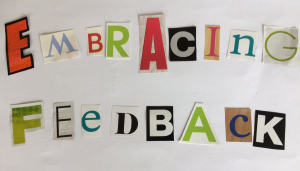As a general rule, most of us would rather avoid feedback rather than “embrace” it, however the process of obtaining feedback from and giv ing feedback to colleagues is valuable, both for the one who is being observed as well as the observer.
Feedback helps instructors identify what they are doing well, increase their confidence, identify how they can improve and reflect on future action. For the observer, it is a great way to not only get new ideas for one’s own teaching, but also a way to build skills in observation and analysis. So you can see, either way it is a “win-win” opportunity. So go ahead…accept the challenge to “embrace feedback”!!
A Guide for Obtaining Feedback from Colleagues
The Teaching Commons at York University identifies the following guidelines for obtaining feedback from colleagues.
PRIOR TO THE OBSERVATION
Have a short meeting to discuss any points of emphasis that you would like examined. The observer should be clear on your goals and should review any relevant material ahead of time (e.g. class outline, homework/ assignment that students were asked to do).
DURING THE OBSERVATION
As the observer, show up on time for the session. The instructor should teach as normal – don’t change because you are being observed! You should introduce the observer to the class and explain the purpose of his or her visit. The observer should comment on all of the categories on the form (if applicable). Any additional observations can be put in the extra space provided or on a separate piece of paper.
AFTER THE OBSERVATION
The observer should review the notes on the form and make any additions that are necessary. If the form is “messy,” rewrite on another form. The peer observer and instructor should meet directly after the class observation to discuss the results. Keep a copy of the observation form for your teaching dossier!
The following guidelines, from the ISW Handbook for Participants (2018) are recommended when receiving verbal feedback:
- Respond honestly and consider all of the comments that are offered.
- Paraphrase or ask for specifics if you’re unsure about what is being said.
- Give honest, experiential responses.
- Remember that you are the one who will ultimately determine what you do with the
feedback. After reflecting on it, you can try it out in future to see if it works or you can
choose not to act on it. - Separate your feelings from the content of the feedback.
- Avoid attempting to re-teach the lesson as a response to the feedback. (If you do, the
facilitator may very well intervene to refocus the conversation.) (p. 30)
Consider creating a form to assist the observer which identifies the particular aspects of your teaching you would like observed and to receive feedback on, such as the Teaching-Observation-and-Reflection-Notes Form.
For a more informal approach, request that one of your peers attend your class and observe your teaching. Follow these general guidelines. For a balanced approach you may want to consider getting feedback on your teaching from a variety of peers, someone from your discipline and someone that is not from your discipline, for example.
Guidelines for Giving Constructive Feedback
You may request that your observer give you constructive feedback that will help you identify the areas in which you excel and the areas in which there is room for improvement. Here is a list from the ISW Handbook for Participants (2018), which describes constructive feedback as:
- Specific, rather than general. Specific information helps the receiver reflect on immediate behavior. General feedback may confuse and can lack impact.
- Descriptive, as opposed to evaluative, and avoids using judgmental terms, such as “good” or “bad.”
- Behavioural, rather than inferential. Refers to what the person does, rather than suggesting reasons for their actions.
- Balanced, in that it provides positive feedback and suggestions for development.
- Manageable amounts of information are provided, without overloading.
- Changeable, in that it is directed toward behaviour that the receiver can change.
- Solicited, rather than imposed. Feedback is often most useful when the receiver has a question the observers can answer.
- Timely, in that it is delivered when the mini-lesson is fresh in the participants’ minds.
- Checked for understanding to ensure clear communication. (p. 28)
Tips for giving verbal feedback
- Focus first on something that went well, perhaps something that served or enhanced your
learning. - Refer to what the person did, rather than to personal characteristics.
- Refer to what you observed or felt, not why you think it happened that way.
- Describe behaviour as more or less, not in judgmental terms such as good or bad.
- Think about the value the feedback will have for the person receiving it, not on the degree
of “release” it gives you to express it. - Address the process and impact of the lesson, rather than talking about the content.
- Address the instructor’s concerns (including the daily posted goals if they are available). (ISW, 2018, p. 30)
References:
ISW International Advisory Committee (2018). The Instructional Skills Workshop (ISW) Handbook Part One: Workshop overview [Beta]. Vancouver: ISW International Advisory Committee.
Teaching Commons @ York. (n.d.) Retrived from https://teachingcommons.yorku.ca/for-cds/workshops-and-courses-for-cds/events-2/nfo/faculty-information-gateway/handbook-for-course-directors/evaluation-of-your-teaching-and-feedback-from-your-students-and-colleagues/obtaining-feedback-from-colleagues/
